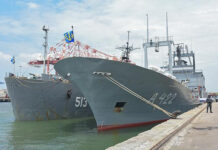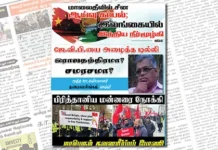The day was July 9, 2022 when the world witnessed unprecedented developments taking place in Indian Ocean island nation of Sri Lanka even as a large number of protestors stormed the President’s palace in Colombo that eventually led to an unceremonious escape of then President Gotabaya Rajapaksa to Maldives and then to Singapore.
As common Sri Lankans came out on the streets in large numbers to protest against the Rajapaksa regime’s disastrous economic policies giving rise to ‘Janatha Aragalaya’ (people’s struggle) with chants of #GotaGoHome reverberating across the island nation. People faced immense food, fuel and fertiliser shortages, long queues in front of petrol stations became a daily occurrence and the worst crisis was faced by the poor and marginal farmers there. Sri Lanka was declared a ‘bankrupt country’.
Globally renowned economists and many international and strategic affairs experts blamed China and its Belt and Road Initiative (BRI) for the soaring crisis and accused Beijing of conducting ‘debt-trap diplomacy’. Several pundits claimed that it was due to the ballooning Chinese debt that stemmed from the BRI projects in that country is why Sri Lanka’s economy headed for a doom. The country defaulted on a $50 billion foreign loan while inflation in that country spiralled out of control.
However, in less than a year since all this happened, Sri Lanka seems to have gone back into the Chinese arms once again.
During a two-day visit to China, Sri Lanka’s Foreign Minister Ali Sabry met Foreign Minister Qin Gang, and according to a statement issued by Beijing, Colombo vowed that it will “ensure the success” of BRI projects apart from staying “firmly committed” to the one-China policy and work for “greater development of strong and robust relations between Sri Lanka and China, and set an example in state-to-state relations”.
That’s not all, both countries also planned to work towards “high-quality Belt and Road cooperation”.
Sabry, who also met the Finance Minister and the Chairman of China’s EXIM Bank, said in an interview to CNBC that he discussed with his counterpart how China can “help” his country in its next phase of development.
Earlier this week, Sri Lanka’s cabinet approved a domestic debt restructuring programme at a special cabinet meeting.
Meanwhile, India has been spending billions of dollars to stabilise the Sri Lankan economy. Last year alone, India offered assistance of about $4 billion to Sri Lanka through multiple credit lines and currency support. In March this year, New Delhi extended the tenure of a $1 billion credit line facility, given in March 2022, till March 2024. India has said it is helping Colombo due to its ‘Neighbourhood First’ policy. But some of its own interests are not being accommodated by the government there, be it political or strategic.
It is due to India’s hard lobbying that Sri Lanka managed to secure a bailout package worth $2.9 billion from the International Monetary Fund (IMF) for which Colombo did thank New Delhi. The IMF package stipulates that Sri Lanka restructure its debt by negotiating with the creditors – India, China and Japan.
In another interview during his ongoing visit to China, Sabry has said Colombo will remain neutral in the growing tensions between New Delhi and Beijing, and wants both countries to talk to each other and resolve their differences.
While the previous Rajapaksa regime was seen tilting towards Beijing before Gotabaya was ousted, under President Ranil Wickremesinghe too India is trying hard to achieve its interests. The Wickremesinghe regime has made it clear to India that both sides will have to “think afresh” on the issue of India’s long-standing demand of implementing the 13th Amendment of the Sri Lankan Constitution on the Tamil reconciliation issue.
The 13th Amendment became part of the 1978 Constitution of Sri Lanka as a direct result of Indian intervention in 1987, under the ‘India-Sri Lanka Peace Accord’. It led to the creation of ‘Provincial Councils’. The main objective of the accord was to establish a mechanism under which political powers would be devolved to the northern and eastern provinces that comprised Tamil-dominated areas of the country. Hence, the 13th Amendment was introduced.
Indian intelligence agencies there do not have an easy run in Sri Lanka anymore which it used to have during the days of the war. Last year, India expressed serious concerns over the visit of Chinese vessel Yuan Wang 5 at Sri Lanka’s Hambantota Port.
According to intelligence sources, China is leaving no stone unturned to develop the Hambantota Port into a military base and Sri Lanka is maintaining silence over the issue. Sri Lanka has also not given its commitment to India on the Trincomalee Sea Port development, which has a strategic importance for New Delhi.
Hambantota Port has always been a security threat to India’s strategic interests since China developed it as part of its BRI project. In 2017, as Sri Lanka failed to fulfil its debt repayment commitments, the port was handed over to China on a lease for 99 years.
In 2021, India failed to bag a strategic project in developing the East Container Terminal of the Colombo Port, which was a government-to-government deal and was instead handed over the West Container Terminal under the private route, which went to the Adani Group.
On the other hand, China has developed a massive township of sorts — Port City Colombo (PCC) — in the Sri Lankan capital by reclaiming 269 hectares of land on the Indian Ocean.
Port City Colombo is a public-private partnership project between the Sri Lankan government and CHEC Port City Colombo Pvt. Ltd, which is a subsidiary of China’s state-run China Communications Construction Company (CCCC), which is leading the BRI.
From a security perspective, India has raised the issue of China’s growing presence there and the threat it poses to India’s national security. India’s Navy Chief Admiral Hari Kumar and Air Chief VR Chaudhari have all visited Sri Lanka in this year. Chaudhari even handed over AN-32 propellers to the Sri Lankan Air Force.
Wickremesinghe is expected to visit India next month. This will be his first visit to India as the President of Sri Lanka. Both sides will be discussing how Colombo will continue to balance its interests between the two sparring neighbours.
ABP News





